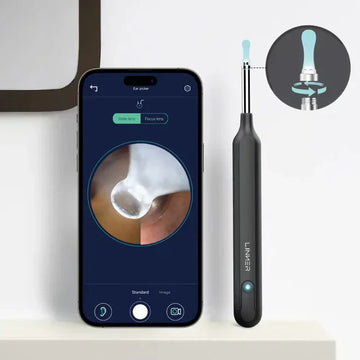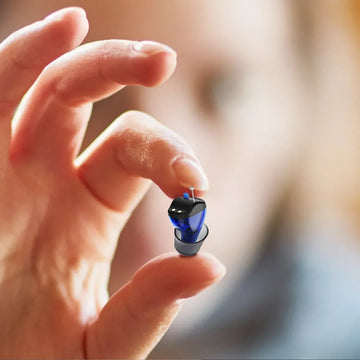If water becomes stuck in your ear, it could cause infections, discomfort and even a brief loss of hearing if you don’t take care of it. Retained moisture in the ear canal is believed to be the main factor for why nearly one in every 10 swimmers gets swimmer’s ear. If you get wet while swimming, bathing or showering, dried moisture should be taken care of right away.
You are able to use safe tools like the correct ear cleaning kit, ear cleaner and mild ear cleaning solution to keep your ears healthy and free from water.
Today, we’ll provide 10 tips from experts to handle and prevent water from getting in your ear and we’ll tell you about the most useful tools for caring for your ears daily.

10 Easy & Effective Tips to Remove Water from Your Ear
Any type of moisture in your ear can lead to uncomfortable and infection. So be cautious about ear after swimming or bath and follow 10 proven tips to get water out from ear.
1. Tilt and Drain
One of the simplest techniques is to tilt your head toward the affected ear and gently tug on your earlobe. This straightens the ear canal, helping gravity pull the water out naturally. You may hear or feel the fluid shift and drain within seconds.
2. Create a Vacuum
Tilt your head sideways and place your palm tightly over your ear to form a seal. Push your palm in and out in a gentle pumping motion. This creates suction, which may dislodge and remove water trapped deeper inside the canal.
3. Use a Warm Compress
A warm compress can relax your ear muscles and get the Eustachian tubes to open up. Put a warm (not scorching) washcloth over your ear for 30 seconds and then tilt your head. This technique is particularly useful if the water seems to be trapped in the middle ear.
4. Use the Blow Dryer Technique
Put your hair dryer on the lowest speed and heat setting. Hold it at least one foot away from your ear and just move it slowly back and forth. The hot air aids in evaporating ear canal moisture. Avoid overheating or getting too close.
5. Use an Ear Cleaning Solution
A combination of equal volumes rubbing alcohol and white vinegar makes a good ear cleaner. The alcohol drives water out, and the vinegar kills bacteria. A few drops can discourage infection and dry out any excess moisture.
6. Chew or Yawn
Chewing gum or yawning movements can also open the Eustachian tubes, permitting air to pass through the ear canal and force water out. It's a low-cost, pressure-based remedy that's particularly effective after a flight or scuba dive.
7. Hydrogen Peroxide Drops
A 3% hydrogen peroxide solution can help break down wax and free up trapped water. Apply a few drops, let it bubble for 30 seconds, then drain. Use this method only occasionally, and avoid it if you have eardrum issues.
8. Don't Use Cotton Swabs
While most people tend to grab them, cotton swabs should be avoided. They tend to force water further into the ear and can injure the thin canal. Instead, use a gentle ear cleaner or ear cleaning kit for effective, safe maintenance.
9. Use a Safe Ear Cleaner
For a smarter solution, consider using the Linner Pictor Visual Ear Cleaner. This advanced ear cleaner provides a live camera view so you can safely remove wax or moisture without guessing. It’s especially helpful for those who deal with frequent blockages or water intrusion.
10. Lie Down on Your Side
Occasionally, gravity will do. Sleep on your side with the hurt ear down. Within a few minutes, water trapped inside should drain out naturally. To get a better effect, put a fresh towel under to soak up the liquid.
With these tips, and good equipment such as a visual ear cleaning kit or natural ear cleaning solutions, you can have dry, healthy ears and prevent discomfort or infection.

How to Prevent Water Intrusion
While removing water is important, prevention is always better than cure. Here are a few proactive ways to avoid water getting trapped in your ears:
· Use earplugs while swimming or showering to block water entry.
· Dry ears thoroughly after exposure to water using a soft towel or blow dryer.
· Avoid inserting objects into your ears that could damage the ear canal and make it more susceptible to water retention.
· Maintain healthy earwax levels, as it acts as a natural barrier against water.
Recommended daily maintenance tools (4-5 items)
Smart Swab Spiral Ear Cleaner – As Seen on TV
This reusable tool features a soft, flexible spiral tip designed to gently twist out wax without pushing it deeper into the ear. It’s a popular alternative to traditional cotton swabs and is safer for regular use.
Linner Pictor Visual Ear Cleaner – LinnerLife
A smart ear cleaner with a built-in HD camera and soft silicone tips. It lets you see and safely remove wax or moisture without blindly poking your ear.
Clinere Ear Cleaners – Clinere
Flexible and disposable tools designed to scoop out wax manually. They’re safer than swabs and help avoid compaction.
WaxVac Ear Cleaner – As Seen on TV
A battery operated device that suction out any moisture and wax to clean ear. It is safer alternative to cotton swabs and reduce potential wax pushing risk.
Regular users of hearing aids should also maintain clean ears for optimal performance. And of course, don’t forget the trusty towel and blow dryer duo for quick daily drying.
Hot Product Recommendations:
When to Seek Professional Help
Sometimes, home remedies and kits aren’t enough. You should see a doctor or ENT specialist if you experience:
· Persistent water sensation after 48 hours
· Ear pain, swelling, or discharge
· Hearing loss or balance issues
· Fever accompanying ear discomfort

Summary
If water stays in your ear for long run, that is dangerous for ear health. In this way using a smart ear cleaner, ear cleaning solution or earwax removal kit can help you safely remove moisture and avoid infection.
For the most effective ear hygiene equipment, try the innovative range from Linner. From visual ear cleaning devices to ear wax removal kits, right through to moisture-safe hearing aids, Linner has it all your ears need.
Read more:
5 Ear Wax Removal Kits for Effective and Safe Ear Cleaning
What Does Your Earwax Color Mean?





